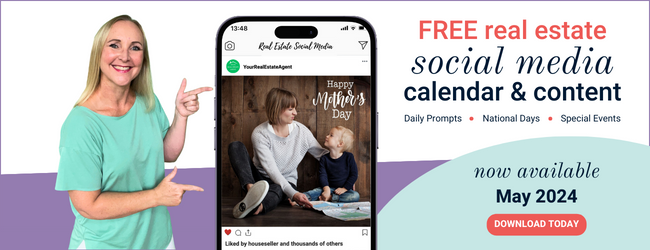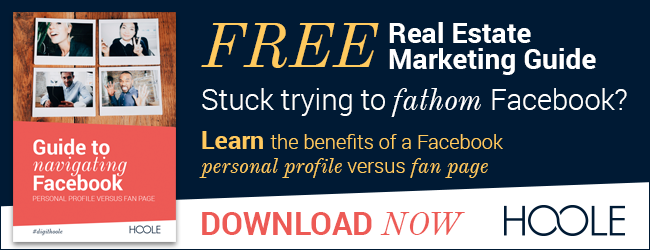If you want to improve your real estate social media marketing, it’s essential to increase your Facebook organic reach. We take a look at the Facebook algorithm, and the content your real estate business needs to be posting if you want to reach a large number of your friends and followers.
Ever wondered how many of your followers are seeing your real estate posts on Facebook? In Part 1 of my two-part series on Real Estate Social Media Marketing, I look at how your real estate business can get the most out of organic Facebook marketing.
If you market your real estate agency on social media, you’ll know Facebook far outstrips the other channels when it comes to the amount of people you can reach. But to make your real estate social media marketing works for you, without having to pay for advertising, you have to increase your organic reach – and that means understanding the Facebook algorithm.
Why the Facebook algorithm matters to your real estate brand
In the early days of Facebook, it was pretty easy for your posts to be seen by pretty much all of your friends. Until 2011, Facebook used an algorithmic system called EdgeRank, which ranked posts in your News Feed using basic information such as when the post was sent and how regularly you interacted with the person posting it.
However, as more and more people started using Facebook, there simply became too much content for every post to be shown in the News Feeds of every single one of your connections. This is why, from 2011 onwards, Facebook has been using an increasingly sophisticated machine learning algorithm that uses information provided by humans (namely the data scientists) to perform complex calculations that determine how highly each post should rank with your connections’ News Feed.
The Facebook 48 hour time lag
This increased volume of content means that most your updates are no longer seen by friends and followers on the day you post. In fact, posts may be seen up to two days later. This is most evident on special occasions such as public holidays. Think back to days or events like Christmas, New Years Eve, Australia Day, Anzac Day and Halloween. It’s days like these when it becomes most apparent that our posts now have a 48-hour time lag, and that’s assuming they are seen at all.
Understanding the Facebook algorithm is, therefore, critical if you want to get the most out of your real estate social media marketing and ensure your posts are received by as many of your connections as possible.
How the Facebook algorithm ranks your posts
The job of the Facebook algorithm is to decide which posts you are most likely to want to see. It does this by taking over 100,000 factors, determined by the data scientists, and breaking them down into four criteria which the algorithm then uses to make its decisions.

According to Adam Mosseri (VP, News Feed at Facebook) these four criteria are:
1. Inventory
This is the amount of content being posted by your friends and the pages you follow. The more connections you have, the more content the algorithm has to organise on your News Feed.
2. Signals
These come from the person who has posted the content and include a huge number of factors such as how frequently that person posts, how long people typically spend interacting with their content. The amount of clicks, likes and shares this particular post already has, whether any of your friends are tagged or have recently commented on their post and whether the person posting the content has previously received any negative feedback.
3. Predictions
These are based on your previous interactions with Facebook – who your friends are, which pages you follow, and the type of content you usually like, share and spend time engaging with. Facebook then makes predictions about how useful and interesting you are likely to find a particular post.
4. Score
Finally, the algorithm takes all the above information and incorporates other factors such as the format of the content (text, image, video or live video), how many keywords it contains and how many ads the person posting the content has running. Facebook then gives the post a relevancy score which ranks the post in your News Feed alongside other peoples content. A higher relevancy score will push your content to the top of someone’s feed.
Phew!
Remember, as everybody interacts with Facebook in different ways, the algorithm is continually being tweaked to become more “human” and unique to each individual user. This is why no two News Feeds are the same.
How Fan Page content is ranked within Facebook’s organic feed
Your organic reach is the amount of people your content reaches without you paying for advertising. If you have your own real estate agent Fan Page on Facebook, the decisions of the algorithm affect your organic reach in a number of ways.
Firstly, as more and more businesses now choose to pay for advertising on Facebook, organic (or free) content posts from pages are given a lower priority in the News Feed. Also, Facebook attempts to encourage businesses to pay for advertising by prioritising content from friends and family over organic content from Fan Pages.
So if you want to improve your Facebook organic reach, and ensure your real estate social media marketing activity is seen by as many people as possible, it’s important to devise an algorithm-friendly Facebook marketing strategy.
Focus on making relevant connections on Facebook
To determine how relevant your content is likely to be to your friends and followers, the Facebook algorithm initially only shows your post to approximately 2-4 percent of them. This applies every single time you post. If the connections who initially get to see your post spend time engaging with it, clicking on it, commenting on and sharing it, it’s then shown to more of your connections.
This means that the quality of your connections is more important than the actual number of followers your page has – you need to be targeting people who are most likely to interact with the content you post. By targeting a specific audience – for example, homeowners living in your selling area – and gradually growing that audience, your posts will reach your ideal audience.
Because of this, it’s not a good idea to invite absolutely everyone to follow your page, as Facebook takes into account how targeted your audience is by looking at the similarities between your followers when it decides how highly to rank your posts. As it only tracks up to 20 new page likes per week in its statistics, it would seem that Facebook ideally wants you to grow a highly targeted audience slowly but consistently.

Only post quality content on Facebook
It goes without saying that your content has to be relevant and useful to your audience. You should also watch your spelling and grammar – remember that Facebook looks at the quality of your previous posts and the engagement they’ve received when deciding how to rank your current one.
Also, keep it honest – “clickbait” content, such as anything that uses a misrepresentative headline or is misleading in any way, will get you penalised.
The more useful and interesting your content is, the more your followers will interact with it, and the more people will ultimately get to see your updates and messages.
Post regularly on Facebook, but not too much
Your content will rank higher if you regularly log in and interact with your followers, which is why it’s essential to have a steady stream of fresh content to keep people starting conversations with you on Facebook. However, the most you should post is once a day. If you post more than this, you are essentially asking the algorithm to choose which of your posts should get maximum visibility. While this will generally be the first one you post, if another post receives more engagement it can get promoted more, pushing your original post out of sight. This is a waste of good content that might otherwise have received a lot of engagement!
And as mentioned above, an organic post is generally visible in the News Feed for around 48 hours until it disappears. This is why you have to capitalise on that window of time as much as possible.
Always check your Facebook vital statistics
It’s also important to get into the habit of monitoring your Facebook page statistics once a week to check your page is on target. You can find this information under the Insights tab. There are four stats here which will give you enough information to improve your content strategy.
These are:
- Page reach: The total number of people your content has reached that week.
- Post reach: The number of people each individual post has reached.
- Post engagement: The amount of engagement each post has received.
- Website visits: The number of clicks through to your website.
In my view, your website visits are the most important statistic, because once people land on your website you can retarget them, send them free marketing materials and encourage them to subscribe to your email list. Negating the need to pay to reach them in the future.
If your posts are reaching less than 100 people organically you should be rethinking your Facebook marketing strategy. If you then choose to boost your post and it reaches less than 1,000 people, it’s time to ask for help!
As with all things, getting your Facebook marketing right takes time and patience. But now you understand the Facebook algorithm better you can devise a winning content marketing strategy. Plus, if you continue to monitor your page statistics, the figures will show you exactly what your audience wants to see, so use that information to guide the content you post. That’s the secret to getting your content seen by more people, and slowly but surely growing your Facebook audience.
This was part 1 in a series on real estate social media marketing, read part 2:
Why you have to “Pay to Play” on Facebook.


Join the Conversation - add your thoughts